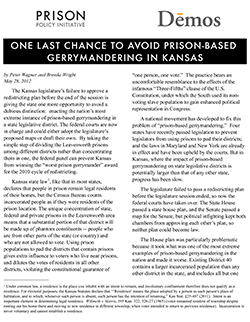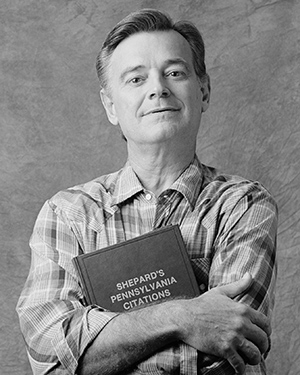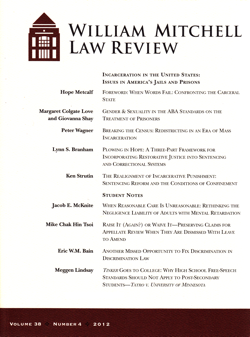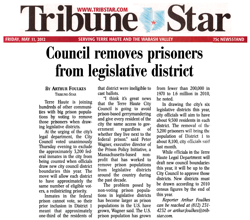New court documents are now available from the Fletcher v. Lamone case, which seeks to overturn the Maryland law ending prison-based gerrymandering.
by Leah Sakala,
May 30, 2012
I’ve just updated our Fletcher v. Lamone page with the defendants’ Motion to Affirm. The plaintiffs in this case want to roll back a major civil rights victory in the state of Maryland by seeking to overturn the 2010 law ending prison-based gerrymandering.
A federal three-judge panel unanimously rejected the lawsuit in December, and the plaintiffs are now seeking to appeal to the U.S. Supreme Court. The Supreme Court will decide whether or not to take the case in about a month.
The federal Judges drawing Kansas' legislative maps can take a few simple steps and keep Kansas from having the most extreme instance of prison-based gerrymandering.
by Peter Wagner,
May 28, 2012
 This morning, Brenda Wright of Dēmos and I released a new report: One last chance to avoid prison-based gerrymandering in Kansas.
This morning, Brenda Wright of Dēmos and I released a new report: One last chance to avoid prison-based gerrymandering in Kansas.
The report is timed to the two-day federal trial that starts tomorrow morning that will redraw Kansas’s legislative districts. If the Court were to adopt the House’s proposed map, Kansas would end up with a dubious distinction: having the nation’s most extreme instance of prison-based gerrymandering in a state legislative district.
Every 4 residents of House District 40 (in Leavenworth) would have the political influence of 5 residents in any other district in the state. Long-term solutions exist, and, as our report recommends, there is one interim solution that the federal judges drawing the new maps could easily implement.
Late last month, in a remote Pennsylvania prison, a voting rights pioneer took his own life. I offer my remembrances of Jon E. Yount.
by Peter Wagner,
May 22, 2012

Photo of Jon E. Yount reprinted from Doing Life © by Good Books (www.GoodBooks.com). Used by permission. All rights reserved.
Sometime in the early morning of April 26, in his cell in a remote Pennsylvania prison, a 74-year-old jailhouse lawyer serving a life sentence took his own life. He was a quiet man who avoided taking credit for his work, so many people in and outside of prison don’t know about the debt they owe to Jon E. Yount.
I knew Jon well, although not as well as I’d have liked. We corresponded a few hundred times, with him writing more than me, and I visited him four or five times. A careful reader of this blog might recognize Jon’s name from the Prison Policy Initiative advisory board, but very few people know that Jon was the first person to recognize how the Census Bureau’s prison miscount could distort state legislative redistricting.
In the late 1990s, Jon and filmmaker Tracy Huling, working independently, linked the Census Bureau’s practice of counting incarcerated people as residents of the prison location to negative political and economic effects. Tracy and Jon’s efforts started people talking about it, and it was this “rumor” that I initially set out to debunk. I was skeptical that the prison system was large enough for census counts of correctional populations to distort the federal budget or congressional districts. It turns out that the Census Bureau’s prison miscount did have only a very tiny effect on the distribution of federal funds, but it was Jon’s work that first drew my attention to the distortion on state legislative districting.
I didn’t know it until after I had completed my first report, Importing Constituents, Prisoners and Political Clout in New York, but Jon had written a thesis about felon disenfranchisement that mentioned the Census Bureau’s prison miscount, and he was also working on a lawsuit about these issues. But that’s getting ahead of the story, a story about a man who experienced the transformation of America’s criminal justice system from the inside and who relentlessly fought to remedy the injustices he found.
The offense and the trials
Jon Yount committed a horrible murder in 1966 when he was 27 years old. In a few moments, a young woman’s life ended forever; and in the eyes of the state of Pennsylvania, those moments were to define the rest of Jon’s life. He rejected the state’s view, and spent the rest of his life showing to himself and those who were watching that he was much better than his worst act.
After his death, I re-read some of the court decisions from his case. The experience was a stark reminder of how trials used to be conducted in this country. Jon’s first conviction was thrown out because the police had violated his constitutional rights. (The Supreme Court’s landmark Miranda case protecting defendants from unconstitutional interrogation techniques came down after his arrest.) At his second trial, 77% of the jury pool in the small rural community was familiar with the case and had already formed an opinion against him. Worse, 8 out of the 14 jurors stated their bias and were kept on the jury anyway. The Judge refused to move the trial.
A federal magistrate thought that this trial, too, violated the Constitution. The district court disagreed, but a three judge panel on the Third Circuit found that Jon,
… has shown that the pretrial publicity caused actual prejudice to a degree rendering a fair trial impossible in Clearfield County. After examining the totality of circumstances, we hold that petitioner’s [second trial] was not fundamentally fair.
Yount v. Patton, 710 F.2d 956, 972 (3d Cir. Pa. 1983)
Unfortunately, by a 7-2 vote, the Supreme Court reversed the Third Circuit’s positive decision. The Supreme Court’s word was final, but Jon, ever cognizant of vote totals and trends once summarized the point in a letter that “Thus, by a narrow 7-6 margin, the federal judges who reviewed my case let the conviction stand.”
The sentence and the escape
Even though the top court in the nation had upheld his conviction, Jon still had a realistic chance of seeing freedom again. Decades ago, a life sentence didn’t necessarily mean a person would die in prison. When Jon was convicted, lifers served an average of about 12 years prior to commutation. He was a model prisoner and was recommended for a commutation after he had served 7 years. He didn’t receive that commutation, nor did he receive any of the others he was recommended for in the first 20 years of his sentence.
Frustrated, and with the number of commutations granted by the governor in free fall, Jon had enough.
Continue reading →
The William Mitchell Law Review has published Peter Wagner's new, highly-readable introduction to the problem of prison-based gerrymandering and its remedies.
by Peter Wagner,
May 22, 2012
 The William Mitchell Law Review has published my new article, “Breaking the Census: Redistricting in an Era of Mass Incarceration.”
The William Mitchell Law Review has published my new article, “Breaking the Census: Redistricting in an Era of Mass Incarceration.”
Above the 98 footnotes is a highly-readable introduction to the problem of prison-based gerrymandering and its remedies. The final section of the article discusses best practices for state and local governments that wish to abolish prison-based gerrymandering.
The article is in Volume 38, Number 4, a special issue called, “Incarceration in the United States: Issues in America’s Jails and Prisons.”
"One-person, one-vote should not just be a concept; it should be reality."
by Leah Sakala,
May 17, 2012
I’ve been writing a lot about Terre Haute, Indiana lately. Most recently, I shared a Tribune-Star article with the good news that the city recently joined the majority of counties and municipalities with large prisons when city councilors unanimously decided to abolish prison-based gerrymandering.
Yesterday, the Tribune-Star released a strong editorial praising the city’s decision to not allow the Census Bureau’s prison miscount to distort local democracy:
The one-person, one-vote concept is the bedrock of the constitutionally guided U.S. electoral process. The council’s unanimous vote to leave the penitentiary population out of the district division formula solidifies Terre Haute’s compliance with the promise of equal access to government representation under the U.S. Constitution.
This is a perfect example of how the media plays a huge role in the movement to abolish prison-based gerrymandering. After we corresponded back and forth with Tribune-Star columnist Mark Bennett, he wrote a 2010 column that put prison-based gerrymandering on the public’s radar and triggered a community-wide discussion about how to solve the problem. Since then, Tribune-Star journalists such as Arthur Foulkes and Howard Greninger have kept the public informed as city officials deliberated on how to keep prison counts from compromising city residents’ right to vote.
And yesterday’s Tribune-Star editorial rightfully affirms that the city took a step in the right direction by abolishing prison-based gerrymandering.
The editorial implies that the U.S. Constitution requires the Census Bureau to count incarcerated people as residents of the prison, leaving the cities like Terre Haute to find their own solutions. Actually, the U.S. Constitution is silent on the question, and hopefully the Census Bureau will end this problem nationwide in 2020. But right now, the only way Terre Haute could avoid prison-based gerrymandering was to take action on its own.
As the editorial explains, “One-person, one-vote should not just be a concept; it should be reality.” And in cities like Terre Haute, with the support of publications like the Tribune-Star, “one-person, one-vote” will now be a reality.
New Jersey bill to end prison-based gerrymandering (SB 1055) passed the Senate's Committee on State Government, Wagering, Tourism & Historic Preservation.
by Aleks Kajstura,
May 15, 2012
Will New Jersey be the next state to end prison-based gerrymandering? Yesterday, S1055, a bill to count incarcerated people at home for redistricting purposes, passed the New Jersey Senate’s Committee on State Government, Wagering, Tourism & Historic Preservation.
Senator Cunningham introduced the bill in January, and the bill was now up for consideration before the Senate committee. There was great turn-out in support of the bill, and I joined several people in presenting testimony: Brother Aula Sumbry (Integrated Justice Alliance of New Jersey), Dr. Johanna Foster (Integrated Justice Alliance), Alex Shalom (ACLU – New Jersey), Nicole Plett (Building One New Jersey), Lawrence Hamm and Jean Ross (People’s Organization for Progress), and Scott Nolen (New Jersey Institute for Social Justice).
When voting to pass the bill, Senator Turner (District 15) noted that she was voting in favor of the bill even though she had large prisons in her district. If New Jersey values fairness and equality as much as Senator Turner does, then the state will soon be the 5th in the country to end prison-based gerrymandering at the state level.
New York and Maryland implemented their laws ending prison-based gerrymandering this past redistricting cycle and California and Delaware’s laws will first apply after the next census. The New Jersey bill will now go onto the full Senate.
Please vote for Peter Wagner to receive the Maria Leavey Award to honor his decade of work to end prison-based gerrymandering.
by Leah Sakala,
May 14, 2012
Today is the last day to cast your vote for Peter Wagner to receive the Maria Leavey Tribute Award for his decade-long work to end prison-based gerrymandering. Campaign for America’s Future presents this award annually to honor an “unsung progressive hero.”
Peter was chosen as a finalist for the award in recognition of his leadership in the movement to abolish prison-based gerrymandering. Our friend and advisory board member Bruce Reilly wrote a great blog post that explains why he voted for Peter and why you should, too.
Thanks for your support, and for sending the message that prison-based gerrymandering must end.
City Council votes unanimously to exclude the prison population for redistricting purposes.
by Leah Sakala,
May 11, 2012

The Tribune-Star reports good news for democracy in Terre Haute, Indiana:
Terre Haute is joining hundreds of other communities with big prison populations by voting to remove those prisoners when drawing legislative districts.
At the urging of the city’s legal department, the City Council voted unanimously Thursday evening to exclude the approximately 3,200 federal inmates in the city from being counted when officials draw new city council district boundaries this year. The move will allow each district to have approximately the same number of eligible voters, a redistricting priority.
The City Council’s decision is especially good news given the federal prison’s ballooning population growth over the last decade. Because the prison nearly doubled in size since the last redistricting cycle, the distortion of prison-based gerrymandering would have been particularly dramatic this time around: two people who live in the district that contains the prison could have had as much say in city affairs as three people in any other district.
Moving forward, residents of the city council district with the prison will no longer be granted unwarranted additional political clout at the expense of all other residents.
Way to go, Terre Haute!
Calif. Assembly passes bill improving law ending prison-based gerrymandering: includes federal prison populations and increases data precision.
by Aleks Kajstura,
May 9, 2012
California’s historic law ending prison-based gerrymandering is about to get even better. The California Assembly just passed a bill (AB 1986), that improves California’s law ending prison based gerrymandering, passed as AB 420 last summer.
Last summer, AB 420 (now Section 21003 of the Elections Code) presented a uniform state-wide solution to California’s problem of prison-based gerrymandering, making California the fourth state to end the practice. AB 420 aimed to prepare the State to count incarcerated people at home for redistricting purposes after the 2020 Census, and AB 1986 proposes to make improvements to the law based on New York and Maryland’s implementation of their laws ending prison-based gerrymandering.
AB 1986 extends AB 420 to apply to prison populations in federal prisons. AB 420 only provided for the collection of home addresses of people incarcerated in state prisons.
AB 1986 also increases the precision in the required data. Currently the redistricting data is only requested to be adjusted by zip code, but the new bill expressly references Census blocks, which are the smallest geographic unit used by the Census Bureau. Switching to Census blocks creates more precision while also creating greater compatibility with the Census Bureau’s redistricting data sets.
Lastly, AB 1986 puts greater privacy protections in place. It requests that the Commission not publish the home addresses of incarcerated people, but only the final population data aggregated to Census blocks.
A full bill analysis is available from the Assembly Committee on Elections and Redistricting. AB 1986 is now up for committee assignment in the Senate.
Prison-based gerrymandering is confounding state legislative redistricting efforts in more ways than one.
by Leah Sakala,
May 8, 2012
Will the Kansas State House districts become one of the biggest examples of prison-based gerrymandering in the nation? The proposed House redistricting plan certainly is, but time is running out and the House and Senate are refusing to approve the other chamber’s plans.
In a recent Kansas City Star column, Mary Sanchez pointed out that, “Kansas has the potential for shenanigans like no other state, thanks to the high concentration of inmates in the Leavenworth area.” She’s right: almost a quarter of proposed House District 40 is incarcerated in Leavenworth-area state, federal and military prisons. The district is somewhat over-populated, but the effect of the prison is massive. If the proposed House districts become law, every 4 voters who live near the prison will have the same influence as 5 voters in other districts.
The impact of prison-based gerrymandering is a little smaller in Kansas Senate districts because they contain more people, but the distortion is still numerically significant due to the concentration of Leavenworth prisons. In the Senate’s proposed plan, nearly 8% of the State Senate District 5 is incarcerated.
But the benefits of ending prison-based gerrymandering in Kansas extend even beyond electoral fairness. A Leavenworth-area paper recently featured the question of how to split Leavenworth County between multiple State Senate districts. The problem is that Leavenworth County is too large, by Census figures, to be a single Senate District, confounding the efforts of those who want to keep the community from being divided.
Here’s the kicker: after removing the population inflation caused by prison-based gerrymandering, the number of actual residents in Leavenworth County is just about right for the county to be its own district.
If Leavenworth County residents want to avoid being divided between two Senate districts in this round of redistricting, they should consider insisting on ending prison-based gerrymandering. Fairness in redistricting often has a lot of positive side effects.







